-
Posts
6,486 -
Joined
-
Last visited
-
Days Won
10
Content Type
Profiles
Forums
Blogs
Gallery
Events
Store
Posts posted by Brian Wolfe
-
-
I agree that it looks like a tobacco stain but how did you determine this?
In the past I have cleaned enamelled equipment that has had very heavy tobacco staining. The worst was a meat scale where the butcher had set his lit cigarett in the ash tray just under the edge of the tray where the meat would be weighed. Years and years of smoke flowing under the scale had left it looking like it was coated with brown lacquer. We would never be allowed, by law, to smoke in a butcher shop in this day and age. I used a cleaner, I think it was in a spray bottle and called "Janitor In A Drum" but any spray cleaner such as "Fantastic" should work. Don't spray the medal but use a Q-tip and soft tooth brush as previously suggested.
I like vinegar as a cleaner but remember that it is an acid (5% Acetic or Ethanolic acid) so care not to leave the acid on too long is important. Any all-metal medals may be immersed in the vinegar and this is where it is very important to be very careful as to their time of exposure.
Good luck and please post your finished restoration.
Regards
Brian
0 -
The Boers never carried bayonets. Funnily enough, bayonets for the Mauser they used - with ZAR (Zuid Afrikaans Republik) markings have been turning up in Chile. They are quite valuable.
Don't forget in WW1 very many bayonets were shortened - by both sides - to act as fighting trench knives. Only when the Fairburn Sykes commando knife was brought out for WW2 was there a dedicated fighting knife.
My thoughts were perhaps someone on horseback or, in a wagon shortened it for a hand weapon - after the 1879 Zulu War there were so many Martini Henry bayonets around that they used to line pathways with them.
When you say "someone" may have shortened it I take it you mean non-military personnel?
I don't think it looks like a trench weapon of the WW I period though I've seen shortened sword blades rehandled for that purpose.
Regards
Brian
0 -
Hi Mervyn,
I used to collect bayonets in a big way and I don't recall anything about shortened bayonets for the purpose of fighting. At lease nothing official. If these were used by the Boers then it may have been shortened for that purpose by them. Aa interesting bayonet and I hope some of the bayonet collectors here at GMIC with more current information than my memory can add some information.
Regards
Brian
0 -
I wonder if any GMIC member has examples of the medals awarded to Indian troops during the Korean War? The medals were:
General Service Medal 1947 with bar "Overseas Korea/1950-53"
Overseas Medal/Videsh Seva with bar "Korea"
Pictures of these medals would be much appreciated. Kevin R Ingraham's excellent book on the medals of the Korean War has only black and white photos of these medals. Strangely, this book makes no mention of an Indian version of the UN Korea Medal.
Regards
Brett
Hi Brett,
I only wish that I did. The GSM 1947 with the Overseas Korea clasp is VERY expensive and of course rare. The Viesh Seva with Korea clasp is also pricy, I had to pass on a group of four with one that was priced at $500.00 US as I was short of cash at the time, the rank was a good one as well. Looking back I think I should have drawn the money out of another account and purchased it. Oh well, no use crying about it now.

I hope someone has one to post.
Regards
Brian
0 -
Hello - Brian. Congratulations on your ascendency ! I like the way you have mounted this whistle - shows it off very effectively. These old whistles were well made and just kept getting re-issued - my own was Victorian.
Prior to the 1880's the method of alarm was for a constable to carry a rattle. Tests were carried out in the early 1880's and it was found that a whistle could be heard three times as far as a rattle. The change over was gradual and the early whistles were of the pea type - however it was found there was confusion with other whistles and Hudson's brought-in the air type.
For a Chief Constable to have his Force name stamped-on, cost extra money - so many of them are un-named. A good one like this - about £30 - but I have heard of them fetching higher prices. Out of interest is that roughly what you paid ? Next time ask me first - I literally have several cupboards filled with this old Police paraphanalia.
Hi Mervyn,
I usually don't add what I paid to my posts, just a quirk of mine, as I'm not an investor just a collector.
However, since you asked I have no problem telling you what I paid. It was $85.00 Canadian or about 46 GBP. I will keep you in mind in the future for police memorabilia...how's the postal strike progressing by the way?
Regards
Brian
0 -
this group was awarded to:
3946819 NK./HAV. ANGREZ SINGH, DOGRA R.
His medals are as follows:
Paschimi Star: 3946819 HAV. ANGREZ SINGH, DOGRA R.
Sangram Medal: 3946819 HAV. ANGREZ SINGH, DOGRA R.
Sainya Seva Medal - Jammu Kashmir clasp: 3946819 NK. ANGRAZ SINGH, DOGRA R.
25th Independence Anniversary Medal: 3946819 HAV. ANGREZ SINGH, DOGRA R.
9 Years Long Service Medal: 3946819 HAV. ANGREZ SINGH, DOGRA R.
Note the spelling error on the Sainya Seva Medal of ANGRAZ rather than ANGREZ. The regimental numbers are all the same so we know this to be the same soldier for all of the medals in this group. Spelling errors are not that uncommon as while the names are in English quite often the engraver is not familiar with the language and errors are unavoidable.
NK. = Naik (Corporal)
HAV. = Havildar (Sergeant)
R. = Reriment not "Rifles" as is often thought by those not familiar with post Independent Indian medal naming.
From his medals we can determine that he served during the 1971 Indo-Pakistan War (Sangram Medal) and from the Paschimi Star we know he was serving in a combat zone during that conflict. The Sainya Seva clasp shows service in the Jammu and Kashmir regions. Research into the Dogra Regiment shows that they were active in the Jammu and Kashmir region in 1948. During the 1971 War they served in the Punjab so this may very well be where this soldier earned his combat star. The 25th Independence Anniversary Medal shows service in 1972 and he was still serving in 1973 as that was the date the medal was authorized for issue.
The court mount was done by me as the medals arrived unmounted.
References for this short article is from:
Medals and Decorations of Independent India by Edward S. Haynes and Rana T.S. Chhina, 2008, Manohar Publishers
Bharat-Rakshak at http://www.bharat-rakshak.com
Regards
Brian
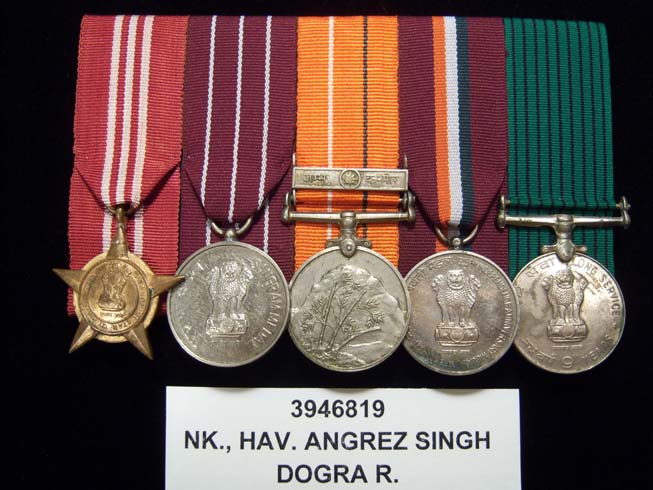 0
0 -
Ulsterman,
Great photo even if it could have been clearer.
At least you can tell what the medals are, I've seen and owned much poorer quality photos.
This gentleman saw a great deal of history the days of the British Empire era.
Thanks for posting it.
Regards
Brian
0 -
 I really like the Medical Group!!!
I really like the Medical Group!!!  I collect groups to medical personnel.
I collect groups to medical personnel. Doc
DocThanks Doc.,
I look forward to seeing your medical groups when you get around to posting them. Until then here is the only other Army Medical Corps medal I have. I have a pair of medals to the I.A.M.C. but they are not for this threat (lets keep it pure
 )
)This is a Sainya Seva Medal for those who are not familiar with the medals of Independent India.
All of the rest of the information is on the display card.
Regards and keep those post 47 medals coming.
Brian
 0
0 -
Is it a ciollar badge?As I recall, versions of these with St Edward's Crown were worn by Specials in Cambs Constabulary on the shoulder strap above "collar numbers", after the dark blue on light blue (Cambridge blue?) cloth sewn on shoulder titles were dispensed with, around the time they were allowed to wear helmets as well as caps.
Badger, where are you?
In fact, yes, I think I've seen WWII illustrations of this badge being worn as a collar badge.
Hi Leigh,
I just ran down to my evil workshop (#2) to take this photo and when I pulled up the web site I see you have made an addition to your reply.
When I did my pre-post research all I could find of any photo of an officer wearing collar badges was this one with the Staffordshire knot under the crown. I made the assumption that the Specials would have had the same regulations.
Regards and thanks Leigh,
Brian
 0
0 -
Hi Brian, Hudsons were at 131 Barr Street from 1885 to 1888. so yes it is victorian
Many thanks Ian.
I must admit that I never thought of searching for Hudsons at 131 Barr Street.

Thanks again,
Brian
0 -
This group was awarded to, 4439189 SEP. GURBAX SINGH, SIKH L.I. (Sikh Light Infantry). His medals are as follows,
Samanya Seva Medal - Kutch-Kargil 1965 clasp: 4439189 SEP. GURBAX SINGH, S.L.I.
Raksha Medal: 4439189 SEP. GURBAKS SINGH
Sangram Medal: 4439189 SEP. GURBAX SINGH, SIKH L.I.
25th Independence Anniversary Medal: 4439189 SEP. GURBAX SINGH, SIKH L.I.
9 Years Long Service Medal: 4439189 SEP. GURBAX SINGH. SIKH L.I.
SEP = Sepoy (Private)
Note the spelling error on the Raksha Medal and absence of his regiment. This is not all that uncommon on Indian medals as there is a problem with the names being in English and the engraver not being familiar with the language. As the regimental numbers are all a match we know these all belong to the same soldier.
From his medals we can determine he was serving during the 1965 Indo-Pakistan War (Raksha Medal) and by the Sangram Medal we can see he was serving during the 1971 Indo-Pakistan War as well. The absence of stars would indicate that he was not serving in a combat zone during either conflict. The Samanya Seva Medal 1965 is a general service campaign medal for military operations and replaced the former General Service Medal 1947. In this case the campaign was in the salt flats of Kutch and the Kargil sector of the high Himalayas against the Pakistani forces. The 25th Independence Anniversary Medal shows he was serving on 15 August 1972. The 9 Years Long Service Medal is self explanitary but from the dates of the first Indo-Pakistani War it is evident he served 10 years or more.
Research for this post came from the book, Medals and Decorations of Independent India by Edward S. Haynes and Rana T.S. Chhina 2008, Manohar Publishers.
This group arrived loose and the court mount was done by me.
Regards
Brian
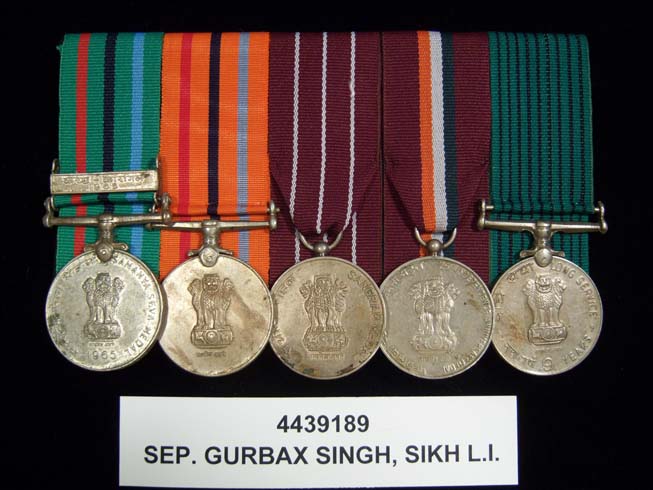 0
0 -
This group was awarded to 6586519 L.NK./NK./HAV. GOPAL SINGH A.M.C. (Army Medical Corps). His medals are as follows:
Samar Seva Star : 6586519 LNK. GOPAL SINGH A.M.C.
Paschimi Star: 6586519 HAV. DVR. GOPAL SINGH A.M.C.
Raksha Medal: 6586519 LNK. MT GOPAL SOINGH A.M.C.
Sangram Medal: Unnamed
Sainya Seva Medal - Bengal-Assam Clasp: 6586519 NK. GOPAL SINGH A.M.C.
9 Years Laong Service Medal: 6586519 NK-MT GOPAL SINGH A.M.C.
L.NK = Lance Naik (same as Lance Corporal)
NK = Naik (Corporal)
HAV. = Havildar (Sergeant)
From his medals we can see that he served during the 1965 Indo-Pakistan War (Raksha Medal) and served in a combat zone (Samar Seva Star). From the Sangram Medal we know he served during the 1971 Indo-Pakistan War and the Paschimi Star indicates service in a combat zone. He also served in the Bengal Assam area as indicated by the clasp to the Sainya Seva Medal and was in the forces for at least nine years but less than twenty is this is all of his medals. It looks like he served as a driver in the Army Medalical Corps, Motor Transport. Whether he was transporting wounded or medical supplies to the front this soldier probably saw the very worst face of war, in his role as a driver.
This group arrived loose and I court mounted them.
Regards
Brian
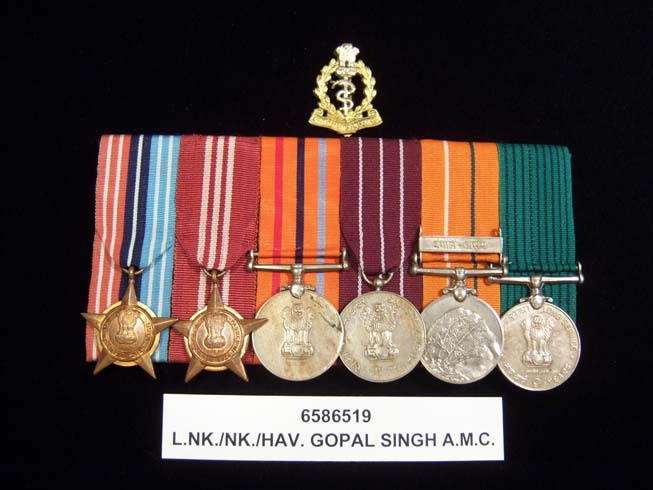 0
0 -
Here is a closer view of the engraving.
It's difficult to properly photograph an object that is cylindrical but I think it shows fairly well.
I'm not sure how common these are but it is only the second one that has surfaced (to me) since I started collecting to the Staffordshire Police about three years ago. The first one went for more than I had in my reserves at the time. This one came up and I was lucky enough to have a fair amount in my reserves. I braced myself for a health bidding war and wouldn't you know it I was the only bidder. I guess the only other collector that didn't already have one was me!

Regards
Brian
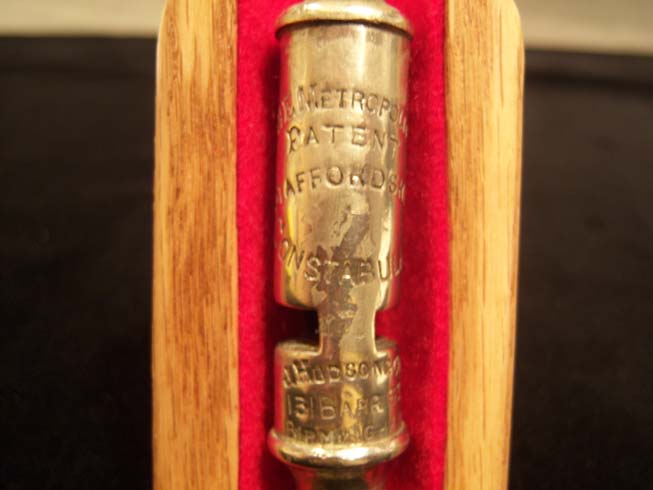 0
0 -
Hello Everyone,
I have just added this police whistle marked to the Staffordshire Constabulary to my collection. It measures 18mm at the collar and the barrel is 16mm in width. The total length of the whistle is 83mm. It is marked The Metropolitian, Patent, Staffordshire Constabulary, J. Hudson & Co., 131 Barr St, Birmingham. I built the dispaly stand in my shop and is oak with red felt lining.
The dealer claimed this was from the Victorian period but I have my doubts, I'm thinking that perhaps Geo V, WW I era. I would like to hear from more experienced collectors as to the date they would think most likely, it would be most appreciated.
Regards
Brian
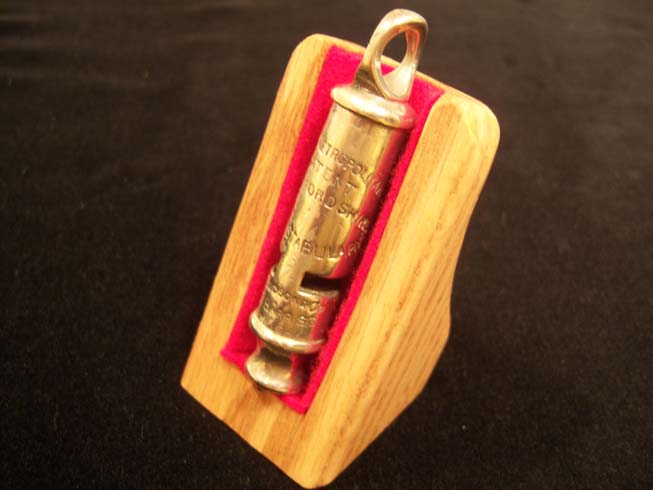 0
0 -
Hello Everyone,
This is a collar badge for the Special Constabulary of the type used by the Staffordshire Police. These are generic and while I can not say that this one was actually used by the Staffordshire Police force it is exactly the same pattern. The badge with its King's crown measures 16 mm in width and 21.5 mm in height. As indicated by the photo the badge is afixed by means of a cotter pin that runs through two eyes soldered to the back of the badge.
Regards
Brian
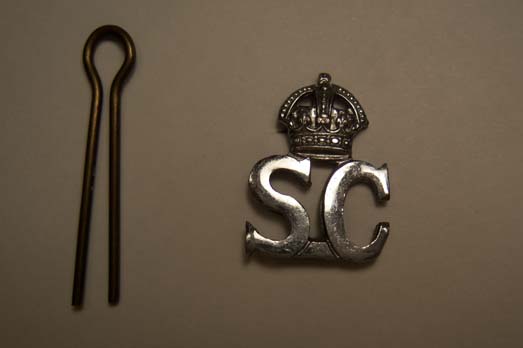 0
0 -
That is a REALLY nice certificate!
Maybe as a local item it was in addition to the Medal rather than something which came with one?
That's a good point Rick as I have only seen this one offered for sale. If there were one certificate for each medal I would think there would be a quite a few available.
Regards
Brian
0 -
Hello Everyone,
Here is a certificate to Special Constable Ernest Walter Sturt of the County of Kent COnstabulary for service during the First World War. I don't have his medal and keep watching for it to surface but I'm afraid that is an exercise in futility.
I hope you like it.
Regards
Brian
 0
0 -
Wat Tyler led the Peasants revolt of 1381
Thanks Foo Fighter, I just came "in" from the workshop and was going to take a coffee break and "Google" it.
Regards
Brian
0 -
I don't know what this is, presumably it's a lapel rather than tie badge from its size & fitting, but the shield is the arms of London, I think that it's just possible to make out "Wat Tylers Sword" top left as viewed? (or it may be a blemish).
Hi Leigh,
That is indeed the sword you mention, the photo is not clear but the badge is in perfect condition. It seems a bit large for a lapel pin. The ones I've seen here are about the size of the blue ring with City of London Police that is on this badge. Even if I can not find the purpose of the pin I now can research Wat Tyler. Many thanks for the additional information.
Regards
Brian
0 -
Here is a view showing the reverse and the attachment pin. As you can see this looks to be a new item as it is in perfect condition.
Thanks again for any help you might be able to give me.
Regards
Brian
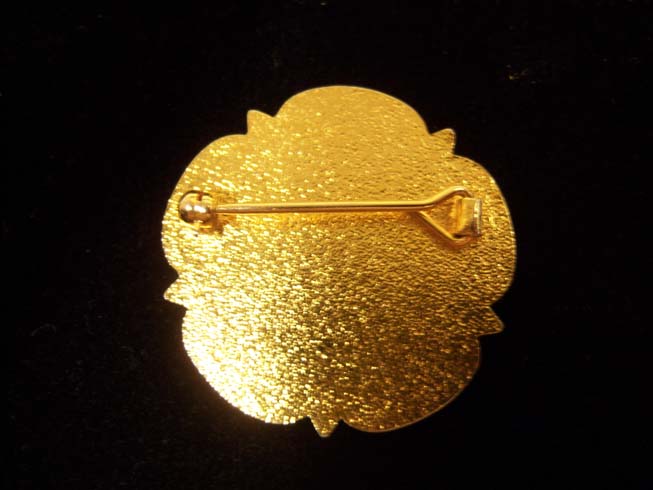 0
0 -
Hello Everyone,
I have just purchased this 31mm diameter pin marked City of London Police and featuring the George Cross. There is no maker's mark and I do not believe this to be old by any means. I bought it simply because I liked it and now would like more information. The photo is not as clear as I would like but that's as good as I could manage this evening.
Would this be similar to a sweetheart pin or possibly a pin for a police organization within or associated to the London City Police?
Your help would be greatly appreciated.
Regards
Brian
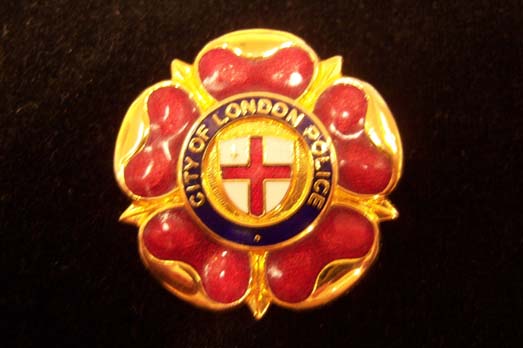 0
0 -
Very nice grouping and definately not a subject i would start "sleeping" ... definately not!
Regarding the soldiers unit, which is it?
And if you know that, are there some kind of regimental histories or anything else getting to know, what his unit did, while he was serving there?
Thanks, and definately keep going!
Christian
Hi Christian,
Records are very hard to find regarding such history. I have a friend in India (Punjab) who tells me that finding out this infomation is impossible from my end and next to impossible from his. It's too bad as the Indian-Pakistani Wars were fought with an intensity not often found in post WW II conflicts and the history of these brave soldiers should not be lost.
Many thanks
Brian
0 -
This last photo show the printed script that I was asking about.
S.M.W.
3266
Would this indicate pre-war manufacture?
Thanks again for any help you can give me.
Regards
Brian
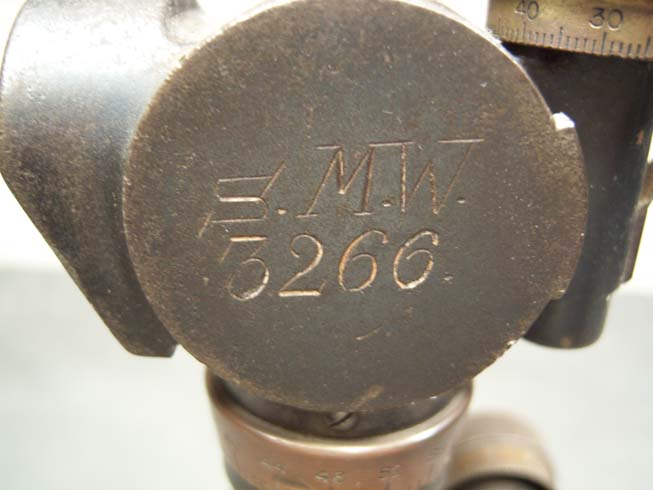 0
0 -
On the top is printed,
H. 160
Rundblick-
Fernrohr Nr. 104033
D.R.P. Nr.156039
I don't know what this stands for so I hope one of the members can help with that as well.
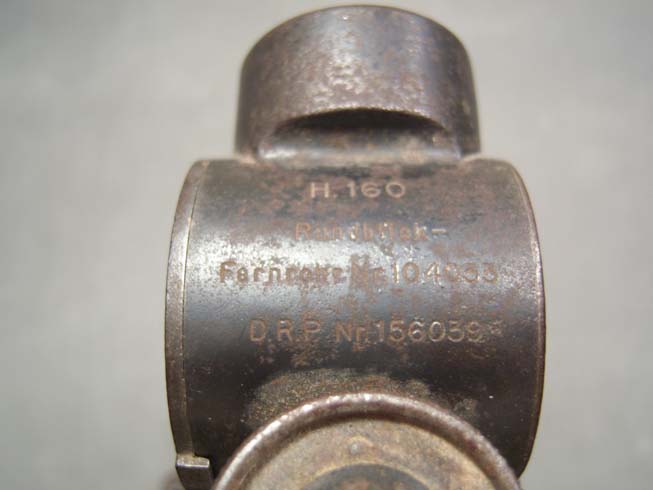 0
0




Silver "signum Laudis" And His Former Owner
in Austro-Hungarian Empire
Posted
Hi Iver,
Very nice medal and how wondeful that you know the recipient.
Would this be the actual medal he wore for the portrait or was it common to own more than one medal, I'm thinking for different functions where the mount may be different. I've know cases, from different nations than your fellow, where tailor's copies were made and worn rather than take the originals out in the crewel world.
I'm not suggesting this is not original as I'm sure it is. I'm just wondering if it was the one in the portrait. I've also known cases where medals were added after the original portrait was completed as more medals had been awarded later on.
Regards
Brian